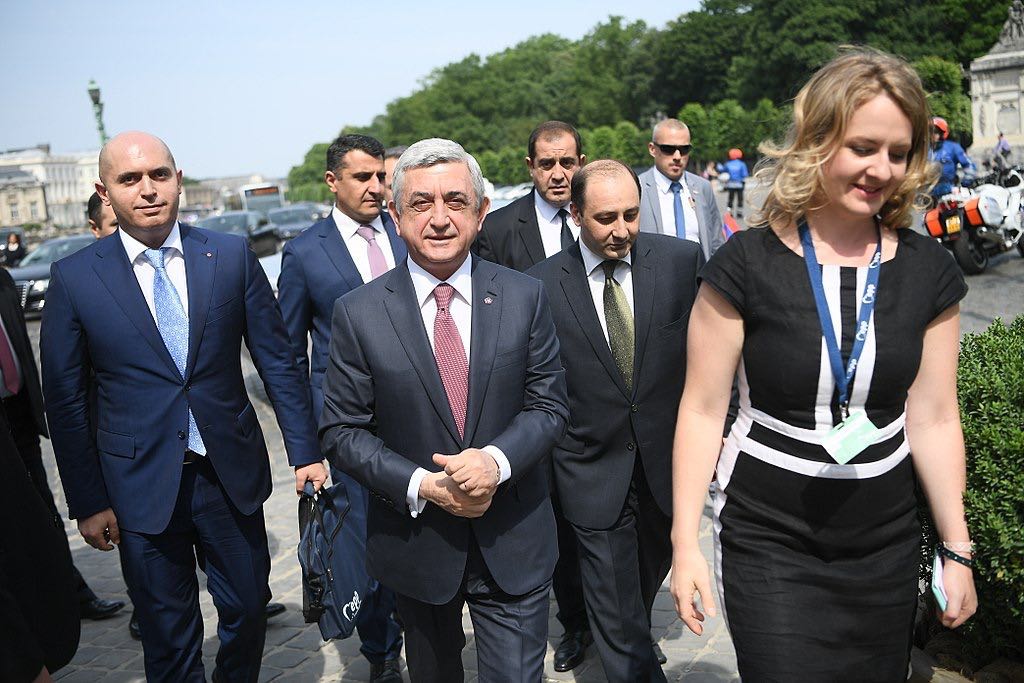The Armenian prime minister Serzh Sargsyan has resigned after mass protests in the streets of Yerevan. In contrast to the Maidan protests which led to the flight of the Ukrainian leader Janukovich, the Kremlin doesn't see the forced resignation in Armenia as a coup d'état, inspired or organized by the West. Caucasus-expert Thomas de Waal explains why.
by Thomas de Waal
When a leader is deposed by street protests in any Russia-allied post-Soviet country, analysts from Washington to Moscow jump to geopolitical conclusions faster than you can say 'George Soros.' But sometimes, as in Armenia these past several days, government-toppling protests are just government-toppling protests.
On April 23, Serzh Sargsyan resigned as Armenia’s prime minister under pressure from mass civil unrest, led mainly by young people, in the capital, Yerevan. The streets of the city turned into an exhilarating carnival of people power that surprised most Armenians.
 Serzh Sargsyan, then Armenia's president, in Brussels in June 2017 at a summit of the European People's Party
Serzh Sargsyan, then Armenia's president, in Brussels in June 2017 at a summit of the European People's Party
But we should not expect this to have geopolitical repercussions beyond Armenia’s borders, nor should we see it as a signal of Russian decline or as a prompt for potential Russian intervention. Sargsyan’s downfall is not about geopolitics. At most, it is a sign that post-Soviet regimes are not as secure as they look from a distance and that the region’s old regimes are perfectly capable of crumbling peacefully without any push from the outside.
Armenia is a difficult country to characterize. It does not fit into a neat international category. It is small, with only 3 million people, but its far-flung diaspora, from Boston to Beirut, keeps it on the map. It’s an ally of Russia but with a strong connection to California and the U.S Congress through its diaspora. Despite being overwhelmingly Christian, it has a good relationship with the Islamic Republic of Iran.
Armenia’s people are poor but highly educated, and its current political system is neither authoritarian nor democratic. Since 1999, one party, the Republican Party of Armenia, has dominated, and two men, once close friends — Sargsyan and Robert Kocharian — have served as president. In April, Sargsyan’s second and final term as president ended, leaving this ruling group with a quandary about how to perpetuate its time in power.
The business-political elite that run the country wanted continuity and Sargsyan to stay as leader, this time as prime minister under a changed constitution in which the role of president would be downgraded and the head of government became the de facto leader of the country. In 2014, Sargsyan said he would not take the prime ministerial job. This month, he took it all the same — either because he was dissembling and wanted power for himself in perpetuity or because the ruling elite needed him to.
Unexpected result
We may never know his real motivation because on April 23 Sargsyan resigned as prime minister, less than a week after taking the job and in the face of mass street protests. This was all unexpected, even to the protestors themselves. They do not have any formal organization and barely any representation in parliament. Their de facto leader, Nikol Pashinian, is a former newspaper editor who does not lack courage or ideas but who is mostly untested in high politics.
This was a rejection of Sargsyan for sure. But it is worth pointing out that, within the limits of the one-party system he sat atop of until recently, Sargsyan had done a fairly good job in recent times. He made some good appointments and diversified Armenia’s foreign policy away from complete reliance on Russia. His prime minister, Karen Karapetyan — who had the job a couple of weeks ago and looks set to get it back — delivered 7 percent economic growth and greater investment. A new Comprehensive and Enhanced Partnership Agreement was signed between Armenia and the European Union last year to balance its membership of Vladimir Putin’s Russian-led Eurasian Economic Union.
We shouldn’t look at the events in Armenia, then, through a geopolitical prism. They are decidedly not a rejection of Russia. Armenia looks out at two closed borders, with Azerbaijan and Turkey — a result of an ongoing 30-year-old conflict over the territory of Nagorno-Karabakh. The country’s military alliance with Russia stems from that and is deemed essential to national security. (The new opposition wants to lessen Russia’s economic hold over the economy, but that is a different matter.) Nor does Pashinian, the de facto opposition leader, dissent from the consensus line of the political establishment, which is opposed to making concessions over Karabakh, which Armenians fought over with Azerbaijan and have held since 1994.
The events of April 23 are about more than one man. They are the result of a system that has formed over 20 years in which business and politics have fused, in which many criminal types and veterans of the Karabakh conflict seized lucrative sectors of the economy and have not surrendered them. Over that period, emigration has become a safety valve, bleeding the country of some of its brightest talents, who could not find proper employment in this system.
This article was published originally by Foreign Policy

